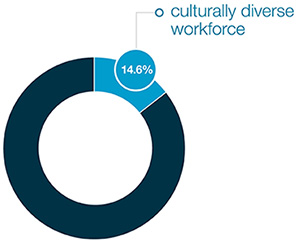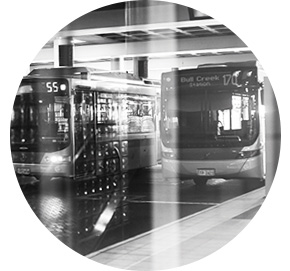- Home
- Operational Report
- Our People
Our People
Nine employees recognised for 40+ years’ service during this year


- 7230 job applications received for 118 positions offered
- 70% of the workforce employed in operational areas
The People and Organisational Development division contributes to the PTA’s business performance by providing strategic programs and projects and a range of essential human resource policies, processes, systems and services.
POD takes the lead role in ensuring the PTA achieves its KRA to secure a workforce with the right capabilities and attitudes to realise our vision. To accomplish this, POD works collaboratively with the other PTA divisions to design and implement initiatives to attract, support, develop, manage and retain people with the right skills and qualities to achieve the PTA’s current and future goals.
POD consists of four branches which work together to deliver integrated products and services. They are:
- Learning and Development
- Human Resource Services (HR Consultancy, Recruitment and Establishment, Personnel and Payroll)
- Human Resource Strategy
- Labour Relations
People matrix

- 1594 Total number of employees as at June 30 (1538 previously)
- 59% Employees with the PTA for more than five years
- 7230 Applications received in 2013-14 (118 were offered positions, including offers to appointment pool)
- 178 Number of people commencing employment in 2013-14

Occupational groupings
- Operational (involved in the day-to-day processes of delivering a public transport system): 70%
- Infrastructure (construction and maintenance of tracks, signals, stations and other facilities): 20%
- Train drivers: 18%
- Transit officers: 17%
- Customer and ticketing service staff: 13%
- Service delivery support/admin (policy development and implementation, safety, contracts, communication and other corporate areas): 10%
- Engineers: 4%
- Road coach operators: 2%
- Signal and electrical technicians: 2%
- Catenary maintainers (electrical overhead): 2%
- Railway track maintainers: 2%
- Train controllers: 1%
- Contract administrators: 1%
Strategic people management
In keeping with our Corporate Plan, a key focus of the PTA is to secure a workforce with the right capabilities and attitudes (KRA 2 of the Strategic Plan 2014- 17). POD’s branches collectively address the strategic people-management challenges facing PTA in a variety of ways.
A new branding strategy is being rolled out, with an initial focus on our recruitment and induction activities. The strategy, along with appropriate training, will continue to be implemented through 2014-15. Individual and tailored branding efforts have already been successful in attracting candidates in some difficult-to-fill positions. Rolling transit officer recruitment campaigns and targeted recruitment are other strategies that have continued to help secure our workforce, as has continued streamlining of processes.
Workforce planning is progressively being embedded and aligned with normal planning processes across the organisation with particular emphasis on key operational areas – N&I and TTO. The planning is helping identify current and future workforce needs and capabilities, with action plans being developed and monitored. Workforce forecasting is being introduced to better highlight future and current resource gaps.
The Leadership Competency Framework is a key tool that has helped articulate the values, capabilities and attitudes the PTA wants from its workforce. This has been promoted across the organisation, starting with a cohort of 20 key leaders who are undertaking a program based on the framework and comprising principles of good leadership: 360 degree feedback, contextualised learning and application to the workplace. A series of two-hour leadership workshops to support this initiative started in June 2014, allowing employees to cover the spectrum of leadership attributes.
A Succession Risk Management Program is being implemented across the organisation to ensure we have strategies in place to develop and secure the workforce required in critical roles. The PTA’s employee appraisal system, My Action Plan, continues to be enhanced to support the growth of individual and organisational capability.
The PTA Graduate Program remains an important vehicle to attract and retain high-calibre employees. This will be complemented and supported with a shift towards “growing your own” staff capability and talent. This is most notable in operational areas, where outside technical skills or expertise is hard to recruit.
We remain strongly committed to continuously reviewing processes in accordance with public sector human resource management standards, to sustain a high standard of merit, equity and probity. As part of our continuous improvement strategy, reviews of some key policies and procedures have been undertaken with subsequent guidance and support to our managers and staff to ensure an approach that is fully aligned to PTA values.
Learning and Development
The L&D branch continued to work on lifting business performance and productivity by improving employee skills and knowledge. This includes a proper induction for new employees, technical training for newly-introduced processes and technologies, and the upgrading of skills and refresher training.
In the past 12 months, a big effort has been made to increase employees’ generic skills.
The PTA’s RTO registration was renewed for a further five years, which allows L&D to continue to provide qualifications and skills for employees, some of which are mandatory under the National Bill that came into effect in early 2014.
In the year under review, there were major changes in the transit officer training regime, with the decision to conduct the training internally. This has provided a better product for new TOs. The refresher training has also been improved to concentrate on quality rather than quantity of the required special skills.
Labour Relations
The remuneration and employment conditions for PTA employees are governed by industrial agreements registered in the WA Industrial Relations Commission. The Labour Relations branch has continued to undertake a key role in dispute resolution, policy development, enterprise bargaining and the provision of strategic advice to operational managers in relation to work reform initiatives.
Diversity
The PTA’s Workforce and Diversity Plan 2012-16 identifies a range of strategies to ensure that we have the right workforce to deliver business objectives.
The WDP establishes targets for workforce participation among various groups consistent with core business goals and in line with the WA Equal Opportunity Act 1984 and other relevant legislation. It also considers untapped sources of potential employees. Using all sources and encouraging applicants from all diversity groups will enhance the performance of the PTA and its ability to meet core business needs in a changing business landscape.
The PTA aims to employ a workforce that reflects the community’s diversity and provides a workplace where differences are valued and respected. We are committed to creating an environment where all employees and members of the public are treated with fairness, dignity and respect in accordance with equal opportunity laws and principles.
Health and lifestyle
In 2013-14 there was a shift in focus of the PTA’s Health and Wellbeing program from activities to results. In support of this, more attention has been given to rolling out different programs to all PTA employees irrespective of their locations.
Data from previous years shows that most participants were at the Public Transport Centre (PTC) head office. Several initiatives such as provision of programs with online, telephone or face-to-face support were implemented to better accommodate the needs of operational employees.
Educational workshops have been delivered across the different operational areas to increase the program’s visibility and raise employee awareness. With these initiatives, both participation and engagement rates grew, especially in PTA’s operational areas.
Greater emphasis was also based on the reporting and evaluation of different activities and challenges the program offered. Questionnaires were sent to different PTA locations asking for employee ideas on how to improve the program. Most of the responses were from operational employees. This helped with the evaluation of the delivery of the current program and provided further ideas for increasing participation rates across operational areas irrespective of differing work schedules.
In the coming year, the program will continue to target operational employees, improving its metrics, and refining its ability to demonstrate PTA’s return on investment. Greater consultation with stakeholders continues to be of importance.
Service milestones
A number of our people achieved significant service milestones in 2013-14. Awards recognising 40 and 50 years of service went to the following.
| Name | Position | Service milestone |
|---|---|---|
| John Robertson | Safety Manager | 50-year award (Jan 2014) |
| Zygmunt Mortas | Signal Project Engineer | 50-year award (Feb 2014) |
| Peter Martinovich | Executive Director IPLS | 50-year award (Mar 2014) |
| Spasoje Nedeljkovic | Railcar Driver (East Perth) | 40-year award (Jul 2013) |
| Warren De Prazer | Admin and Contracts Support Officer | 40-year award (Nov 2013) |
| Gavin Heaysman | Suburban Operations Officer | 40-year award (Nov 2013) |
| Damian Carrick | Passenger Service Manager Armadale | 40-year award (Apr 2014) |
| Brian Clarke | Perway Patroller | 40-year award (Jun 2014) |
| Robert Rowland | Driver Coordinator Claisebrook | 40-year award (Jun 2014) |


